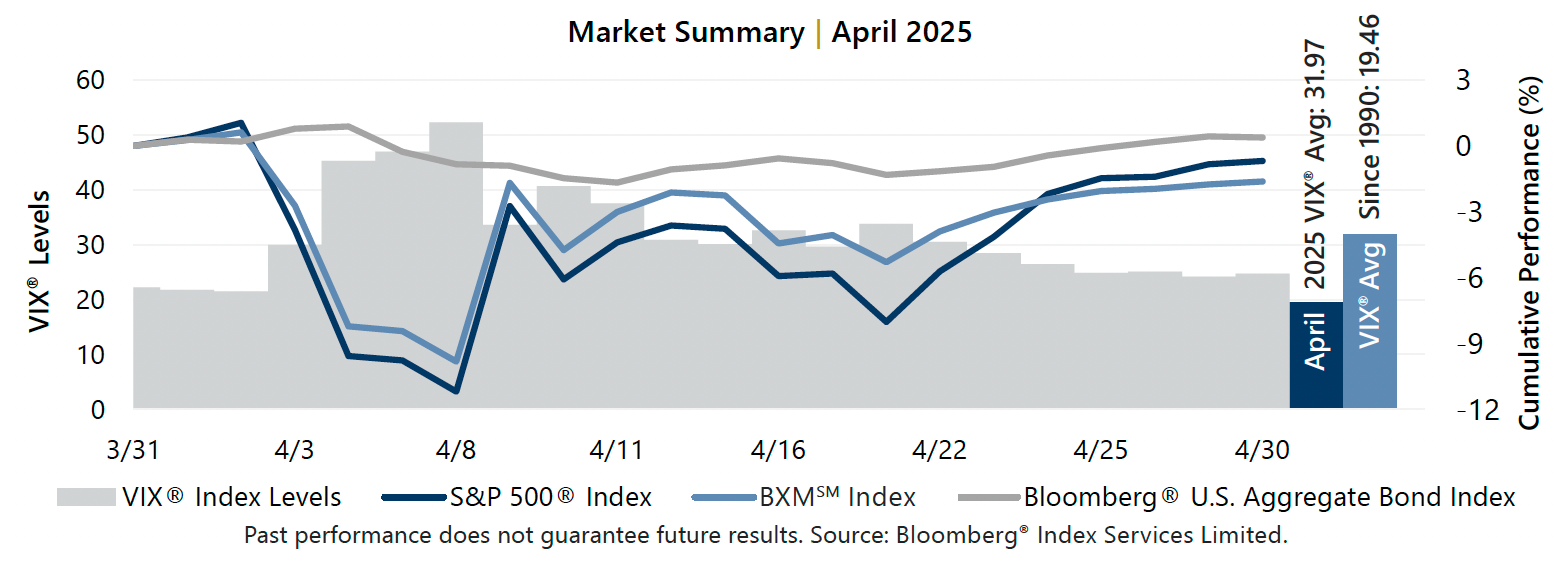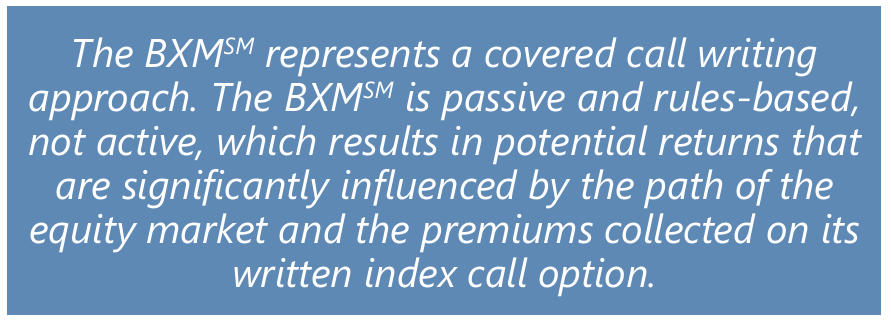 The S&P 500® Index returned -0.68% in April, bringing its year-to-date return to -4.92%. April’s return seems like a reprieve compared to March’s decline of 5.63%, but masks what became the 11th largest drawdown since 1987. From its February 19 all-time high, the S&P 500® Index declined 18.75% through April 8. In April, the announcement of the new U.S. tariff policy and its fogging of growth expectations triggered massive equity market decline and crisis-level volatility. As the news was processed and policy progressed, the market staged an equally impressive recovery. From the start of April through April 8, the S&P 500® Index declined 11.19% before climbing 11.83% from April 8 through month-end.
The S&P 500® Index returned -0.68% in April, bringing its year-to-date return to -4.92%. April’s return seems like a reprieve compared to March’s decline of 5.63%, but masks what became the 11th largest drawdown since 1987. From its February 19 all-time high, the S&P 500® Index declined 18.75% through April 8. In April, the announcement of the new U.S. tariff policy and its fogging of growth expectations triggered massive equity market decline and crisis-level volatility. As the news was processed and policy progressed, the market staged an equally impressive recovery. From the start of April through April 8, the S&P 500® Index declined 11.19% before climbing 11.83% from April 8 through month-end.
Data released in April reflected weakened growth expectations with steady inflation and an uncertain outlook for the labor market. The first estimate of Gross Domestic Product for the first quarter of 2025 was negative for the first time since 2022 and lower than the consensus estimates. The year-over-year March Consumer Price Index released April 10 was less than consensus estimates and the prior period, while the quarter-over-quarter Personal Consumption Expenditures (PCE) Price Index climbed higher than the consensus estimates and prior reading. With just over 56% of S&P 500® Index companies reporting, corporate earnings are on track to be positive for the first quarter of 2025. Aggregate operating earnings increased 2.1% quarter-over-quarter and 10.5% year-over-year. More than 79% of reporting companies either met or exceeded analyst estimates.

Implied volatility, as measured by the Cboe® Volatility Index (the VIX®), averaged 31.97 in April. With significant market movements during the month, average realized volatility – as measured by the standard deviation of daily returns for the S&P 500® Index – exceeded implied volatility. Realized volatility averaged 49.32% for the month. The VIX® ended March at 22.28 and hit an intra-month low of 21.51 on April 2 before climbing to an intra-month high of 52.33 on April 8 – its highest closing level since 2020. The VIX® ended April at 24.70.

 The Cboe® S&P 500 BuyWriteSM Index[i] (the BXMSM) returned -1.63% in April, bringing its year-to-date return to -4.67%. The premiums the BXMSM collected as a percentage of its underlying value provided loss mitigation and are an important component of performance. The premium the BXMSM collected as a percentage of the BXM’sSM underlying value was 3.45% in April – more than 68% higher than the premium collected in March and a reminder of how option writing benefits from heightened levels of volatility. The rules-based timing of the BXMSM’s option writing and the level of premiums collected as a percentage of its underlying value provided significant loss mitigation during periods of market decline and contributed to the BXMSM’s participation in periods of advance. From the start of April through April 8, the BXMSM offset 136 basis points of loss mitigation relative to the S&P 500® Index with a return of -9.83%. As the equity market advanced from April 8 through month-end, the BXMSM climbed 9.09% – capturing nearly 77% of the market’s advance.
The Cboe® S&P 500 BuyWriteSM Index[i] (the BXMSM) returned -1.63% in April, bringing its year-to-date return to -4.67%. The premiums the BXMSM collected as a percentage of its underlying value provided loss mitigation and are an important component of performance. The premium the BXMSM collected as a percentage of the BXM’sSM underlying value was 3.45% in April – more than 68% higher than the premium collected in March and a reminder of how option writing benefits from heightened levels of volatility. The rules-based timing of the BXMSM’s option writing and the level of premiums collected as a percentage of its underlying value provided significant loss mitigation during periods of market decline and contributed to the BXMSM’s participation in periods of advance. From the start of April through April 8, the BXMSM offset 136 basis points of loss mitigation relative to the S&P 500® Index with a return of -9.83%. As the equity market advanced from April 8 through month-end, the BXMSM climbed 9.09% – capturing nearly 77% of the market’s advance.
The Bloomberg® U.S. Aggregate Bond Index returned 0.39% in April, bringing its year-to-date return to 3.18%. The yield on the 10-year U.S. Treasury Note (the 10-year) ended March at 4.21% and reached an April low of 3.99% on April 4 before touching an intra-month high of 4.49% on April 11. The 10-year ended the month at 4.16%.
[1] The BXMSM is a passive total return index designed to track the performance of a hypothetical buy-write strategy on the S&P 500® Index. The construction methodology of the index includes buying an equity portfolio replicating the holdings of the S&P 500® Index and selling a single one-month S&P 500® Index call option with a strike price approximately at-the-money each month on the third Friday of the standard index-option expiration cycle and holding that position until the next expiration.
Bloomberg® Index Services Limited. Please see Important Information section for the full disclosure.
Past performance does not guarantee future results. Sources: Morningstar DirectSM and Bloomberg, L.P.
Bloomberg Index Services Limited. BLOOMBERG® and the indices referenced herein (the “Indices”, and each such index, an “Index”) are service marks of Bloomberg Finance L.P. and its affiliates (collectively “Bloomberg”) and/or one or more third-party providers (each such provider, a “Third-Party Provider,”) and have been licensed for use for certain purposes to GATEWAY INVESTMENT ADVISERS, LLC (the “Licensee”). To the extent a Third-Party Provider contributes intellectual property in connection with the Index, such third-party products, company names and logos are trademarks or service marks, and remain the property, of such Third-Pary Provider. Bloomberg or Bloomberg’s licensors own all proprietary rights in the Bloomberg Indices. Neither Bloomberg nor Bloomberg’s licensors, including a Third-Party Provider, approves or endorses this material, or guarantees the accuracy or completeness of any information herein or makes any warranty, express or implied, as to the results to be obtained therefrom and, to the maximum extent allowed by law, neither Bloomberg nor Bloomberg’s licensors, including Third-Party Provider, shall have any liability or responsibility for injury or damages arising in connection therewith.
For more information and access to additional insights from Gateway Investment Advisers, LLC, please visit www.gia.com.
